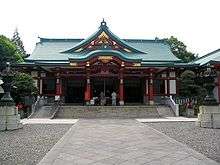Hie Shrine
The Hie Shrine (日枝神社, Hie Jinja) is a Shinto shrine in Nagatachō, Chiyoda, Tokyo, Japan. Its June 15 Sannō Matsuri is one of the three great Japanese festivals of Edo (the forerunner of Tokyo). Other names for the shrine include Hiyoshi Sannō-sha, Hiyoshi Sannō Daigongen-sha, Edo Sannō Daigongen, Kōjimachi Sannō, Sannō-sha, and Sannō-sama.
| Hie Shrine 日枝神社 | |
|---|---|
 | |
| Religion | |
| Affiliation | Shinto |
| Deity | Ōyamakui-no-kami |
| Location | |
| Location | 2-10-5, Nagatachō Chiyoda, Tokyo 100-0014 |
 Shown within Japan | |
| Geographic coordinates | 35°40′29″N 139°44′22.50″E |
| Architecture | |
| Founder | Ōta Dōkan |
| Date established | 1478 |
| Website | |
| www | |
The main god of the shrine is Ōyamakui-no-kami.
History
The date of establishment of the Hie Shrine is uncertain. According to one theory, Ōta Dōkan established it in 1478. Another theory identifies the Hie with the Sannō Shrine mentioned in a 1362 record of the Kumano Nachi Taisha.
Tokugawa Ieyasu relocated it to the grounds of Edo Castle, and in 1604 his son Tokugawa Hidetada moved it out, so the people of Edo could worship there. The shaden was lost to the Great Fire of Meireki of 1657, and in 1659 Tokugawa Ietsuna rebuilt it at its present location. The shrine stands southwest of the castle, in the ura kimon direction according to onmyōdō.
From 1871 through 1946, the Hie Shrine was officially designated one of the Kanpei-taisha (官幣大社), meaning that it stood in the first rank of government supported shrines.[1]
The shaden was lost again to the bombing of Tokyo during World War II. The present structure dates from 1958.
The Hie Shrine possesses one National Treasure, a tachi (single-edged sword). It also holds 14 Important Cultural Assets, 13 swords and one naginata. The shrine is also one of the most popular for Japanese families to visit during the Shichi-Go-San coming-of-age festival.
Tameike-Sannō Station on the Tokyo Metro Ginza Line and Tokyo Metro Namboku Line, Kokkai-gijidō-mae Station on the Tokyo Metro Marunouchi Line and Tokyo Metro Chiyoda Line, and Akasaka-mitsuke Station on the Tokyo Metro Ginza Line and Tokyo Metro Marunouchi Line are the closest stops to the shrine.
Notes
- Ponsonby-Fane, Richard. (1959). The Imperial House of Japan, pp. 126.
References
- Ponsonby-Fane, Richard Arthur Brabazon. (1959). The Imperial House of Japan. Kyoto: Ponsonby Memorial Society. OCLC 194887
- This article incorporates material from 日枝神社 (Hie Jinja) in the Japanese Wikipedia, retrieved September 16, 2007.